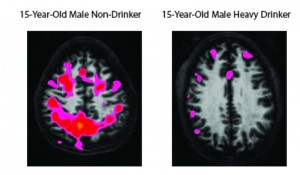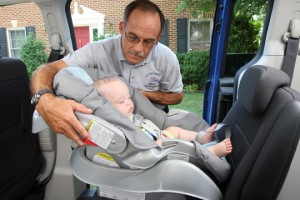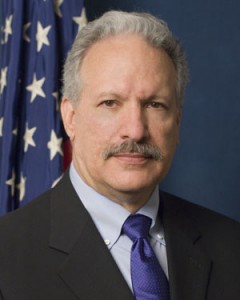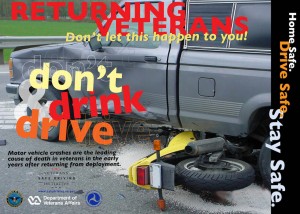17 – Your Cell Phone: It’s Not Worth the Risk

April 7, 2014 | Posted in Distracted Driving, Podcast Episodes | By Traffic Safety Guy
Comments Off on 17 – Your Cell Phone: It’s Not Worth the Risk
Podcast: Play in new window | Download
Subscribe: RSS
“When you decide not to wear your seat belt, you are pretty much endangering only your own life. But when you elect to talk on the cell phone or text, you are not only endangering your own life, you’re endangering the lives of pedestrians and others.” These words were said to National Transportation Safety Board (NTSB) Member Robert Sumwalt at an NTSB Distracted Driving Summit by family members of a loved one killed by a distracted driver.
April is Distracted Driving Awareness Month
April is Distracted Driving Awareness Month and the Traffic Safety Guy is hosting a four-part series on Distracted Driving: what it is and what we can do about it. The series kicks off with a discussion with NTSB Board Member Robert Sumwalt.
In 2012 distracted driving in the United States alone resulted in at least:
- 3,328 fatalities
- 410,000 injuries
The research reveals that someone who texts and drives is 23 times more likely to be in a crash and that 40% of American teens say that they have been in a car when the driver used a cell phone in a way that put people in danger. Expert after expert now declares distracted driving an epidemic.
Distraction a Top Priority at NTSB
The NTSB has taken a strong stand on distraction in general, and cell phones and other “portable electronic devices” (PEDs) specifically, recognizing that distraction in all modes of transportation is dangerous. In January 2014, the NTSB announced its “Most Wanted List” for the 2014 year. “Eliminating Distraction in Transportation” is on that list of 10 priorities.
In this episode Member Sumwalt candidly discusses what needs to be done about distracted driving, noting that cell phone use is one of the most pressing concerns. Almost all states have some form of a ban on texting, whether it is focused on teens or all drivers, because texting is recognized as a major contributor to distracted driving. However, only a handful of states have a ban on hand held cell phones and no state or locality has a complete ban on the use of drivers using a cell phone, hands free or not.
Time for a Complete Ban
Late in 2011, NTSB called for a nationwide ban on the use of portable electronic devices while driving. Hands free cell phone use is no safer than holding the phone in your hand; it is the mind that is distracted from the task for driving. Member Sumwalt continues this call for action, noting that to have an impact on distracted driving there must be good education, good laws, and strong enforcement of those laws.
It is time to have a social stigma attached to driving while using a cell phone, just as it now is socially unacceptable to drink too much and drive. Member Sumwalt pointed out that it took time for the attitude change in drinking and driving and it will probably take time to change the mindset regarding cell phones. One way to start that change is for parents to model for their children what it is to be a safe driver, which includes not using a cell phone while driving.
Businesses Are Taking Action
In 2009, NTSB instituted an agency policy that no employee of NTSB shall use a cell phone while driving. Member Sumwalt indicated that the policy worked to change behavior at the agency, and to lead by example.
But it is not only NTSB that has instituted this policy. A few years back, the National Safety Council did a survey of Fortune 500 companies about their cell phone policies. Looking at potential liability and employee safety, 18% of the companies that responded indicated they had instituted a complete ban on the use of cell phones while driving, including Shell Oil, DuPont, BP, Abbott, Cargill, and Time Warner Cable.
Notably, the vast majority of businesses indicated that there was no reduction in work production, and one-in-five indicated that they had seen a reduction in crashes and property damage.
Why Risk It?
Ultimately, as pointed out by Member Sumwalt, the NTSB recommendations are based on solid research into the underlying cause of crashes. As he asked during the discussion, the real question is: “What makes this phone call so important that I am going to risk my life and the lives of others?”
Related Links:
Websites:
Research:
- Distracted Driving Research
- NSC: Cognitive Distraction
- NSC: Employer Cell Phone Kit
- NSC: Fortune 500 Survey
- NTSB: Missouri Crash Investigation
- NTSB Most Wanted List: Distractions
Other:
Infograph
16 – Road Safety: Understanding Alcohol and Alcohol Addiction

April 1, 2014 | Posted in Impaired Driving, Podcast Episodes | By Traffic Safety Guy
Podcast: Play in new window | Download
Subscribe: RSS
Ruth Bowles is the Executive Director of the Rockland Council on Alcoholism and other Drug Dependence[1] and in this episode we discuss alcohol, a substance that causes a significant number traffic deaths as well as create problems for individuals, families, businesses, and communities.
Now in its 28th year, April is recognized as Alcohol Awareness Month. During April, the National Council on Alcoholism and Drug Dependence (NCADD) and other organizations work to increase public awareness and understanding, reduce the stigma, and encourage local communities to focus on alcoholism and alcohol-related issues.
Most people can have a drink or two with friends or a glass of wine with dinner without consequences. However, for a significant percentage of the population, alcohol-dependence, sometimes called alcoholism, is a serious concern and having even one drink results in a downward spiral. For an alcoholic, “One drink is too many, a thousand never enough.[2]
Alcohol and Crime
Alcohol has a substantial role in traffic fatalities: one-third of all traffic fatalities are the result of impaired driving. Alcohol is also a major factor in many other crimes. Research surveys have found that:
- 5.3 million adults − 36% of those under correctional supervision at the time of the survey − were drinking at the time of the commission of their criminal activity.
- 40% of state prisoners convicted of violent crimes were under the influence of alcohol at the time of their offense − the more violent the crime, the greater the likelihood that alcohol was involved.
- 25% of state prisoners given a standard questionnaire to screen for alcoholism tested positive.
Alcohol problems are not limited to the criminal justice system. In the work place, workers with alcohol problems are 2.7 times more likely than workers without a drinking problem to have injury-related absences. Additionally, one-fifth of workers and managers in a variety of professions report that a co-worker’s on-the-job and off-the-job drinking jeopardized their work effort and personal safety.
Becoming an alcoholic does not happen over night. A person builds up a tolerance over time, and then possibly abuses alcohol before becoming alcohol-dependent. Even then, there are a number of factors that come into play to become an alcoholic. Once the addiction takes over, it almost becomes more important to drink than to breath. Becoming an alcoholic happens over time; getting into recovery also takes time.
Addiction is a Brain Disease
Alcohol Addiction is a brain disease. Brain scans now show just how much a person’s brain changes once they become addicted. Young or old, the brain is significantly impacted. Once in recovery, the brain can partially heal, but like chronic diseases, any recovery is a life-long struggle.
In fact, relapse rates of addiction and/or alcoholism are similar to other chronic diseases, such as Hypertension or Asthma. Take the right steps and you can live a healthy life, but it is a day-in-day-out battle to not relapse. Unfortunately, there is 50-70% chance that a person with Hypertension or Asthma will relapse. Just like those chronic diseases, people suffering alcoholism may slip up and relapse. Someone that has a drug addiction, such as alcoholism, has a 40-60% chance of relapse.
What is important after a relapse occurs is what happens afterwards. Do they take the next steps for recovery? Treatment can play an important role in finding the right steps to understand addiction, and learn potential triggers. A great support group during and after treatment for someone suffering the disease of alcoholism is Alcoholics Anonymous (AA).
Alcohol Awareness Month
The theme for Alcohol Awareness Month is: Help for Today, Hope for Tomorrow. During April there will be a number of local, state and national events aimed at educating people about the treatment and prevention of alcoholism. Recognizing that our youth are our hope for a better tomorrow, many of the activities will focus on the dangers of underage drinking. An integral part of Alcohol Awareness Month is Alcohol-Free Weekend (April 4-6, 2014). During this 72-hour period, everyone is encouraged to remain alcohol-free and learn more about the issues of alcoholism.
Related Links:
Websites:
- Alcoholics Anonymous (AA)
- National Council on Alcoholism and Drug Dependence, Inc. (NCADD)
- National Institute on Alcohol Abuse and Alcoholism (NIAAA)
- National Institute on Drug Abuse (NIDA)
- National Partnership on Alcohol and Misuse and Crime (NPAMC)
- Rockland Council on Alcoholism and Other Drug Dependence
Research
Other
[1] The Rockland Council on Alcoholism and other Drug Dependence is an affiliate of the National Council on Alcoholism and Drug Dependence.
[2] “One drink is too many, and a thousand not enough” is an AA saying that refers to someone who is sober, but returns to his or her bad habits by relapsing. Having just one drink is the start of a backslide into addiction, because no amount of alcohol will satisfy an alcoholic’s cravings.
15 – Child Safety Seats: Are Yours Properly Installed?

March 15, 2014 | Posted in Child Safety Seats, Podcast Episodes | By Traffic Safety Guy
Comments Off on 15 – Child Safety Seats: Are Yours Properly Installed?
Podcast: Play in new window | Download
Subscribe: RSS
Three out of 4 child safety seats are not properly installed. Jennifer Huebner-Davidson, Manager of Traffic Safety for AAA and an expert on child safety seats, discusses some of the common mistakes and what you can do to make sure your child’s seat is properly installed.
Why Child Safety Seats?
Car and truck seat belts are designed for adults. For the best protection, the lap belt should be low and snug across the hips and the shoulder portion must be snug across the chest, away from the neck and face. For many adults, this is not a problem. However, for young children, adult seat belts never fit properly. With an incorrect fit, a child is at serious risk. A child safety seat or booster seat remedy this problem.
Child safety seats are now an accepted feature when a child is in a car. Organizations across the globe call for their use. The U.N. Decade of Action for Road Safety includes child safety seats as an important element in reducing the number of global road fatalities. Parents everywhere are purchasing them and understand the need to have them in the car.
Common Mistakes
The issue now is that many child seats are not properly installed. A few common mistakes include:
- Using the lower anchors and the car’s seat belts in combination to secure the child safety seat.
- Not using a tether when indicated by the manual.
- Placing a child safety seat in the center of the back seat using the lower anchors from the two outside seats.
- Not considering the combined weight of the child and seat when using the anchor system.
Parents are obviously trying to install the seats properly, but mistakes are being made. Some times it is an over abundance of caution creating an issue. For example, using the lower anchors and the seat belt in combination to secure a child car seat would make you think that it is increasing the safety potential. However, there is no research that it is improves a child’s safety and there are concerns it could create problems. Seat belts and the lower anchor system are designed to work independently.
In this episode, Ms. Huebner-Davidson also provides guidance on the type of child car seat that should be used and when to change to a new car seat. Ultimately, as she indicates, one should always first read the Child Safety Seat Instruction Manual and then the vehicle manual.
Proper Installation
Three tips for achieving a successful installation include:
- Read the Child Safety Seat User Manual
- Read your vehicle manual
- Get the seat checked at a Car Seat Check Site
Getting an inspection at the car seat check site allows an expert to determine if the seat is properly installed. If it isn’t, the technician will show you what is incorrect and how to fix it so when you are on your own, you’ll have the knowledge and ability to install it correctly. Click here to find the closest car seat check site to you.
Once your child is old enough and according to the user manual for the child safety seat, the next step is to move to a booster seat. This will help the adult seat belt to properly fit your child. Finally, when your child grows old enough to leave the booster seat behind, remember, they still need to wear a seat belt and ride in the back seat.
As your child grows, providing her or him as much protection as possible from injuries in a car crash requires three steps:
- Purchase the correct child safety seat
- Properly install it
- Use it
You have taken the time to purchase the seat and to install it – make sure to do that last step, and use it. You never know about the driving skills of the person next to you, or if they may be texting while driving or driving impaired. Remember, once you have installed the seat, it should be used Every Ride, Every Time. Using these three steps can help ensure your child has the life he or she was meant to have.
Related Links
Websites:
- AAA – Child Safety
- AAA – Safe Seats 4 Kids
- NHTSA – Car Seat Recommendations for Children
- Car Seat Check
Research:
Other:
- AAA – Latch System Press Release
- AAA – Fact Sheet – New Research on Lower Anchors and Tethers
- NHTSA – The Simple Facts about LATCH
- NHTSA – Lower Anchors and Tethers for Children
- Highway to Safety Podcast – Interview of Kate Carr, CEO Safe Kids Worldwide on Child Safety Car Seats
14 – Drowsy Driving: Take the Time to Sleep

March 1, 2014 | Posted in Drowsy Driving, Podcast Episodes | By Traffic Safety Guy
Comments Off on 14 – Drowsy Driving: Take the Time to Sleep
Podcast: Play in new window | Download
Subscribe: RSS
“Anyone who is human and gets behind the wheel [of a car] should worry about it.” NTSB Board Member Mark Rosekind speaking on drowsy driving.
“There will be sleep enough in the grave.” How many times have we heard someone say something similar, implying that he or she doesn’t need or have time for sleep? Ben Franklin made that statement over 200 years ago and it is still used today, sometimes as a badge of honor. In today’s culture, with many of us traveling in large and potentially deadly weapons on a road or highway, mixing the lack of sleep with driving is a deadly combination. However, there are practical steps each of us can take to avoid these dangers, with acknowledgement of the existence of drowsy driving being the first.
Dr. Mark Rosekind, Board Member of the National Transportation Safety Board (NTSB) and one of the world’s foremost human fatigue experts, examines the fallacy that we can put sleep off to a later time. As human beings, we are hardwired for sleep. We have to breath, we have to eat, we have to drink, and we have to sleep. It is a biological requirement for our survival. Starting with that premise, Dr. Rosekind discusses:
- How much sleep we need
- What happens when we don’t get a sufficient amount of sleep
- How fatigue plays a role in drowsy driving, and
- What we can do about driving and fatigue
Having a “Sleep Debt”
As we age the amount of sleep needed each night changes. What many people do not understand is that teens actually need 9¼ hours of sleep, not the typical 8 hours mentioned. What is especially concerning is that in high school teenagers get on average 6½ hours of sleep. They may think that they are 90 minutes short on sleep, but they are actually more than two hours below what is needed. Adults need 7-9 hours or an average of 8 hours. This is true as we age and become senior citizens, although in our later years our sleep patterns are broken up. We still need the 8 hour average, however, it is not as refreshing thus it is often harder to get a good night’s sleep. Many retirees enjoy a mid-day nap to help make up for the lost overnight sleep. This is why teens and senior citizens are considered higher risks for drowsy driving.
When we don’t get sufficient sleep, we start to build up a “sleep debt.” One night of poor sleep, and our abilities are affected. If we don’t get sufficient sleep a second night, the sleep debt increases. Go a third night, and it continues to accumulate. Go three nights with 2 hours lack of sleep each night, and the sleep debt is up to 6 hours. In a single night, losing 2 hours of sleep can result in a person acting as if they were at a .05 BrAC (Breath Alcohol Content).[1] With a sleep debt, our attention, reaction time and decision making are all significantly effected by as much as 20-50%. A slower reaction time or making a poor decision means not reacting to the brake lights in front of us or seeing the traffic light turning red. Falling asleep while driving can have devastating consequences.
Drowsy Driving’s Impact is Underestimated
How dangerous is drowsy driving? There are estimates in the U.S. that annually we could be looking at a million or more crashes or near crashes – 20% of all crashes could be due to fatigue. All the experts agree that the number of crashes and fatalities due to fatigue is underestimated.
According to the Automobile Association of America (AAA) two out of every five drivers (41.0%) reported having fallen asleep or nodding off while driving, and that one in four reported that they had fallen asleep between the hours of noon and 5 p.m. Drowsy driving happens during the night and during the day.
Drowsy driving is a problem no matter where we live or travel. Last year in India, a bus crashed, killing 45 people. One media outlet reported that the driver admitting he dozed off while driving. Pick any country, and you can find reports of drowsy driving.
Possible Solutions to Drowsy Driving?
Many of us, when we notice we are sleepy while driving, try to “fix” it by turning up the radio or opening the window, or biting a lip. These “remedies” work for only about 10 minutes. Caffeine can provide a short-term jolt, but even that is limited in time and needs to be taken before feeling tired since it requires time for us to feel the effects. Bottom line: We are still sleep deprived and we are still dangerous as we drive down the road.
The only real solution to drowsy driving is sleep, whether it is finding a safe place to stop and get a short nap, such as at a Rest Area or a good night’s sleep before leaving.
3-Step Checklist Before Traveling
To be prepared for any drive, Dr. Rosekind provides a three-step checklist:
- Recognize that fatigue is a risk and ask:
- Do you have a sleep debt from the last night or a combination of nights?
- How long have you been awake at this point?
- What is the time of day when the driving is occurring?
- Do you have a sleep disorder?
- If fatigue is an issue, take a nap or get some caffeine.
- Be sensitive to the environment. Are you driving at night or on a monotonous road? Driving in these conditions can reveal your fatigue.
Individually, each of these steps can raise a red flag. Combined, they ensure we consider what condition we are in, and whether we are safe to travel. Reviewing this checklist can save lives. In the meantime, get a good night’s sleep.
Related Links:
Websites:
- Automobile Association of America (AAA) – Drowsy Driving
- Drowsy Driving.org
- National Sleep Foundation (NSF) – Drowsy Driving
- NTSB
Research:
- AAA Report on Drowsy Driving
- National Highway Traffic Safety Administration (NHTSA) Research on Drowsy Driving
- NSF White Paper on Drowsy Driving
Other:
- Bus Crashes in India Result of Drowsy Driving
- Highway to Safety Podcast Episode #1 – Impaired Driving
[1] .08 BrAC is the level when a person is presumed to be under the influence of alcohol in the United States and some countries. A majority of countries have .05 BrAC or lower as the illegal limit.
13—Driving and Marijuana—A Dangerous Combination

February 15, 2014 | Posted in Drugged Driving, Podcast Episodes | By Traffic Safety Guy
Podcast: Play in new window | Download
Subscribe: RSS

Chris Halsor, Colorado TSRP
For years individuals and organizations everywhere have talked about, and continue to work on combating, the dangers of alcohol-impaired driving. As a result, there has been a significant reduction in alcohol-impaired fatalities. However, impaired driving due to drugs other than alcohol, sometimes called “Drugged Driving,” is a growing concern across the United States and beyond. One of the most common drugs found in substance-impaired driving fatalities is marijuana.
Mr. Chris Halsor is the Traffic Safety Resource Prosecutor (TSRP) [1] in Colorado, where marijuana was first approved by state residents for medicinal use, and more recently for legal recreational use. [2] With the changes in the law, [3] Mr. Halsor has seen a troubling increase in drugged driving cases involving marijuana.
Impairment from Marijuana
Based on the science and the research, there is no question that marijuana impairs a person’s mental and physical? abilities. It is wrong to believe that marijuana use does not result in impaired driving. It is a scientific fact: Marijuana use increases the risk of being in a fatal crash.
Of significant concern is the public’s misunderstanding of the signs of marijuana impairment. Message after message has shown alcohol-impaired individuals with slurred speech, poor balance, and problems walking. Mental impairment is actually a greater issue because 1) driving is a complicated task requiring a person to focus on a number of critical factors simultaneously, and 2) alcohol affects a person’s mind and judgment before the physical signs are visible—meaning a person is already mentally impaired by the time the physical signs are observed. Mr. Halsor noted that the predominant marijuana-induced impairment affects a person’s judgment. The impairment is less about the physical response, but that does not make it any less dangerous than alcohol.
The increasing potency of Delta 9 THC is another concern when considering a person’s impairment. Delta 9 THC is the active impairing ingredient in marijuana. Several years ago the THC concentration was typically under 10%, even as low as 2-6% in a “joint.” Now, the potency is significantly higher and marijuana stores in Colorado advertise this increased potency. It is not uncommon to see ads for 20% potency or greater. It has become a race to the top, resulting in greater impairment.
Putting the THC concentrate into a variety of foods also creates problems. Adding the concentrate to food products results in delayed impairment. People consume these products, do not initially feel any effects and then drive, with the effects impacting them while driving.
Drugged Driving and Per Se Drug Laws
Many states have passed a ‘per se’ law, similar to the .08 breath alcohol concentration (BrAC) per se law for alcohol. Colorado passed a modified per se law that allows jurors to infer impairment if a person has 5 nanograms or greater of THC in their blood.
One argument against a per se law is that marijuana stays in the body for up to 30 days. However, Delta 9 THC is generally in the blood only 1 to 3 hours. The THC that is found in the body days later is THC-COOH, an inactive non-impairing metabolite.
Supplemental Material
Shortly after NTSB’s announcement of the NTSB Most Wanted List in January 2014, the Traffic Safety Guy was able to briefly speak with NTSB Board Member Dr. Mark Rosekind. I asked him about substance impaired driving and the issues marijuana is causing for safe driving. His response is part of this episode.
Related Links:
Websites:
- NIDA – Marijuana Abuse
- NTSB – Most Wanted List
- ONDCP – Drugged Driving
- The Pew Charitable Trusts – How High is Too High to Drive?
Research:
- Fatal Car Crashes Involving Pot Use Have Tripled in U.S.
- Trends in Alcohol and Other Drugs Detected in Fatally Injured Drivers
- NHTSA – 2007 National Roadside Survey of Alcohol and Drug Use by Drivers
Other:
- NDAA – Between the Lines – A New High in Colorado
- Traffic Safety Guy Video – NTSB – Most Wanted List
- Highway to Safety Podcast Episode – Drugged Driving
[1] A TSRP provides traffic-related education, research and technical assistance to prosecutors and law enforcement, with an emphasis on impaired driving.
[2] Marijuana is still considered an illegal drug by the U.S. Federal Government; thus, there is a dispute on whether or not the drug is legal.
[3] This episode is not a discussion on the pros and cons of legalizing marijuana. The focus is marijuana’s impact on traffic safety.
12 – DWI Courts: A Necessary Component in the Battle to End Impaired Driving

February 1, 2014 | Posted in Impaired Driving, Podcast Episodes | By Traffic Safety Guy
Comments Off on 12 – DWI Courts: A Necessary Component in the Battle to End Impaired Driving
Podcast: Play in new window | Download
Subscribe: RSS
The Honorable Peggy Hora, international expert on Drug Treatment Courts, including DWI (Driving While Impaired/Intoxicated) Courts, discusses what DWI Courts are and why they are needed to reduce impaired driving by substance-addicted individuals.
Impaired driving kills. The answer to ending impaired driving is: Stop drinking and driving. While a simple statement, the solution is far from effortless. Because a broad spectrum of individuals are arrested for DWI, different responses are required. In the United States, two-thirds of those arrested will not repeat the crime of impaired driving. The arrest and conviction are sufficient wake-up calls. However, some individuals are addicted to alcohol or other drugs, and the traditional approaches do not work. They continue to drink, then drive, to be arrested and convicted. It becomes an unending cycle, as jail or prison does not change their behavior. For this specific group of offenders, a different approach is needed. That different approach is a DWI Court.
Format of a DWI Court
DWI Courts are different from traditional courts. Based on the Drug Court model, DWI Courts hold repeat DWI offenders accountable and get them to become law abiding citizens by using long-term treatment and intensive supervision. In other words, DWI Courts go after the root cause, the addiction, by providing a comprehensive approach.
DWI Courts are team-oriented, with a Judge as the leader of the team. Also represented on the team are:
- Prosecutor
- Defense counsel
- Treatment provider
- Court Coordinator
- Probation officer, and
- Law enforcement officer.
Using treatment to address the why, the court uses its authority to help ensure that the person follows through by attending all treatment sessions, providing frequent and random samples for alcohol and drug testing, meeting with the judge on a regular basis, and following through with any other court orders specific to the individual (attending school, looking for a job, etc). Everyone on the team is focused on making sure the offender complies with the court’s requirements.
If an offender fails to comply, there are swift and certain consequences that increase in severity if the defendant continues to fail. And, if a person is doing everything correctly, and following the court’s orders – there are incentives or positive responses, including applause, praise, or even small gift cards. The importance of positive responses should not be underestimated, because over the long-term they are more effective in changing a person’s behavior than using negative-only responses.
Change is Hard
During this episode the Traffic Safety Guy also discusses the difficulties of changing a particular behavior. Most people forget that change is hard. It takes focus and continued effort to change a past habit. Many people make New Year’s resolutions, but very few are successful in the endeavor. Others no longer bother to make a resolution because of past failures. Now, add in an addiction to a chemical substance, especially one as socially acceptable as alcohol, and a behavioral change becomes even more difficult. But with a team of supporters holding a person accountable and always recognizing the positive efforts, change is possible.
DWI Courts are changing individuals—one person at a time—for a lifetime. And that is change worth understanding and supporting.
Have you seen a DWI Court? What did you think?
Related Links:
Websites:
- National Center for DWI Courts (NCDC)
- National Association for Drug Court Professionals (NADCP)
- Global Centre for Drug Treatment Courts
- Map to Locate Drug/DWI Courts
Research:
Other:
- 10 Guiding Principles of DWI Courts
- NTSB Report: Reaching Zero: Actions to Eliminate Alcohol-Impaired Driving
Videos:
11 – Returning Veterans and Traffic Safety: Once Home—Stay Safe, Drive Safe

January 15, 2014 | Posted in Podcast Episodes | By Traffic Safety Guy
Comments Off on 11 – Returning Veterans and Traffic Safety: Once Home—Stay Safe, Drive Safe
Podcast: Play in new window | Download
Subscribe: RSS
Motor vehicle crashes are a significant issue for the general population. But here in the U.S. it is even more so for those in the military. From 1999 through 2012, 4,423 active military personnel died in noncombat crashes versus the 4,409 of our soldiers killed in the Iraq war. Motor vehicle crashes are the leading cause of death for veterans in the early years after returning from deployment. In this episode Lieutenant Don Marose with the Minnesota State Police talks about why this is, and what is being done to reduce those numbers when our veterans return home.
Veterans and Re-Integration
Before deployment, many of our servicemen and women are trained on how to drive in a combat zone. The training is intensive and requires the building of “muscle memory,” when a person reacts automatically in certain situations. In a combat zone, they are trained to look for bombs lying alongside of the road or consider vehicles that approach them quickly as a threat. Driving “reckless” in Iraq and Afghanistan, running stop signs and weaving in and out of traffic, may be considered safe driving. When they return home, this driving would be considered aggressive and risky. Yet, that muscle memory is not something that can be turned off automatically.
Minnesota implemented a comprehensive re-integration program in 2005 to support the Minnesota National Guard veterans returning from deployment. The program included a discussion on traffic safety. The main point raised is that it will take time for the soldiers to feel comfortable and safe when driving. They need to understand that they were trained to react, and now they need to understand that this is a different environment requiring a different response—a less forceful response.
In his presentation, Lt. Marose speaks with the returning veterans on a wide variety of traffic safety topics, finishing up with the words that the veterans have put their lives “in harm’s way to defend our country. Our citizens cannot THANK YOU enough for your service. But don’t waste all of that by coming home to die in a stupid car crash!”
The program has spread to other states’ National Guard units and most of the branches of the U.S. Military.
Veterans and The Safe Driving Initiative
Also during this episode, the Traffic Safety Guy provides additional information on what the government is doing to support our veterans upon their return. In 2009, The Department of Veterans Affairs (VA), the Department of Transportation (DOT) and the Department of Defense (DOD) came together and developed the Veterans’ Safe Driving Initiative: Home Safe, Drive Safe, Stay Safe.
The Safe Driving Initiative was created with both short- and long-term considerations in mind. In the short-term, it includes a Public Health Information Campaign reaching out to the various veteran service organizations, state governors, law enforcement officials, and motor vehicle dealers and manufacturers. NASCAR legend and safe driving advocate Richard Petty is also a partner in the initiative. (See below PSA with Richard Petty.) Designed to increase a veteran’s awareness of motor vehicle risks, the focus is on:
- Impaired Driving Prevention (as a driver and as a passenger with an impaired driver)
- Wearing seat belts, and
- Wearing a helmet when riding a motorcycle
Additionally, the VA and the DOT developed a Veterans’ Traffic Safety Strategic Research Plan to look at the long-term answers, understanding that there are still a lot of questions that need answers; questions that include considerations of epidemiology, psychology, and biomechanics.
We have a long way to go to recognize the dedication of our service men and women, but this is a start—to make sure that once they are back home safe, they remain so on our nation’s roads.
Related Links:
Website:
Other:
- Article: Motor vehicle crashes: A little-known risk to returning veterans of Iraq and Afghanistan. The Washington Post: Health & Science. May 5, 2013.
- Article: Tragedy On Wheels: Why Returning Vets Are In Frequent Car Crashes. AOL Autos, October 11, 2011
- Traffic Safety Guy Blog: Veterans: Once Home—Stay Safe, Drive Safe
- Veterans Safe Driving Initiative Brochure
Richard Petty Video/PSA:
10 – Traffic Safety: A New Year; A New Direction

January 1, 2014 | Posted in Global Road Safety, Podcast Episodes | By Traffic Safety Guy
Comments Off on 10 – Traffic Safety: A New Year; A New Direction
Podcast: Play in new window | Download
Subscribe: RSS
A Conversation with Monika Samtani

Monika Samtani
Monika Samtani is an award-winning journalist, a business entrepreneur, and a mother of three. As a media professional for over 20 years, currently the traffic anchor on Washington, DC’s WUSA 9’s Morning News, and the host for a morning news transportation segment called the Extra Mile, Monika provides a unique perspective on traffic safety. She understands the importance for all of us to “just drive.”
Going the Extra Mile
While reporting traffic crashes from around the Washington D.C. metro area, Monika sees the significant impact poor choices can have on driving. Speaking with me between her traffic reports, Monika provides a glimpse into the world of reporting traffic crashes, and why she says, “Just drive.”
During her Extra Mile segment, Monika interviews traffic safety professionals on what can be done to be safer. Her interviews include speaking with Tim Hollister, Author and National Teen Driver Safety Advocate, and Kate Carr, CEO of Safe Kids Worldwide. A side-benefit of all that she has learned at work allows her to share it with her family, including her teenage son who is just learning to drive. Accused by her son of ‘knowing too much,’ Monika discusses what we all need to do to be safe drivers.
In her ‘free time,’ Monika is the President of Ms. Media, producing videos and providing public speaking training, and the founder of the Launch Network, a premiere networking organization connecting entrepreneurs and professional women in the U.S.
A New Direction

Is safety part of your New Year’s Resolutions?
Also during this episode, as the Traffic Safety Guy, I talk about the New Year and call on all of us to take a new direction for safety. For many, the New Year is a time of resolutions and individual efforts for self-improvement. Self–improvement should not be limited to our health. Did you know that:
- A 5% cut in average speed can result in 30% reduction in the number of fatal crashes.
- Not drinking and driving significantly reduces the risk of a traffic crash.
- Wearing a motorcycle helmet correctly can result in a 40% reduction to risk of death and 70% reduction of a serious injury.
- Wearing seat belts reduces the risk of a fatal injury by 50% for the front seat occupants and up to 75% for the rear seat passengers.
- Child restraints reduce the likelihood of a fatal crash 70% for infants and 54%-80% for young children.
What could be more about self-improvement than taking action to be a safer driver?
Many countries have strong national laws covering these specific issues, but the vast majority of countries acknowledge that more has to be done to enforce them. For a societal change, it takes awareness, understanding AND enforcement. Yet knowledge IS power, and each of us can make a difference; a difference in our own lives, and in the lives of those around us.
A New Year’s Resolution for Safety

What direction will your actions take you in 2014?
During this New Year, resolve to take a new direction in your life. Take this time to understand the importance of your actions. Recognize that each of us plays a role in saving lives. Use your expanding awareness and implement new behaviors to be a safer driver.
In this time of reflection of years past and contemplation of dreams to come, I wish you a very safe and joyous journey wherever life’s road takes you.
Happy New Year!
Related Links:
Websites:
Research:
Other:
- Highway to Safety Podcast, Episode 5 – Kate Carr
- Highway to Safety Podcast, Episode 6 – Tim Hollister
Videos
- Drive Sober or Get Pulled Over National Winter Crackdown – U.S. Transportation Secretary Anthony Foxx
- Drive Sober or Get Pulled Over National Winter Crackdown – NHTSA Administrator Strickland
- Drive Sober or Get Pulled Over National Winter Crackdown – MADD President Jan Withers
09 – Impaired Driving: Make Your Plans Before the Celebration

December 15, 2013 | Posted in Impaired Driving, Podcast Episodes | By Traffic Safety Guy
Comments Off on 09 – Impaired Driving: Make Your Plans Before the Celebration
Podcast: Play in new window | Download
Subscribe: RSS

Mike Brown is the Chief of the Impaired Driving and Occupant Protection Division at the National Highway Traffic Safety Administration (NHTSA) and a former Commissioner of the California Highway Patrol. In his current position, he is responsible for coordinating the United State’s policy and programs concerning impaired driving prevention activities and strategies to improve occupant protection. During this episode we discuss why December is an important month to remind everyone to not drink and drive and what is being done to prevent impaired driving across the country.
In many parts of the world, the month of December is a time to celebrate the holiday season; between Hanukkah, Christmas, Boxing Day, Kwanzaa, and New Year’s Eve, it is a virtual cornucopia of festivities. For some people, these festivities mean celebrating with family and friends, which at times includes alcohol—and that is when it can get deadly.
December is National Impaired Driving Prevention Month
On November 29th, President Obama declared December 2013 to be National Impaired Driving Prevention Month. NHTSA will be extremely active in December working with its partners everywhere, promoting the messages of ‘Buzzed Driving is Drunk Driving’ and ‘Drive Sober or Get Pulled Over.’
In the United States, 760 people lost their lives from impaired driving during December of 2011, with a total of 4,169 in the December months from 2007 to 2011. While impaired driving happens all year ‘round, the holiday season is a particularly dangerous time. Because of these devastating facts, law enforcement will be out in force cracking down on impaired drivers from December 17, 2013 through January 1, 2014.
Impaired Driving from Other Drugs

Alcohol is not the only drug that causes impaired driving. Other drugs are playing an increasingly deadly role. From research done by NHTSA, of the drivers tested for alcohol and other drugs, nearly 16% were positive for a drug other than alcohol. This is not to say that everyone was using an illegal drug. Prescription and over-the-counter medications were found as well. It is essential to remember that impaired driving can also occur from medications, both prescription and over-the-counter. That is why we must understand how any medication may impact the person taking it or interact with other medication being taken.
Make Plans Beforehand
Even one drink can impair someone’s judgment and increase the risk of getting arrested for impaired driving, or worse, killing someone. That is why it is important to make plans before heading out for the evening. Easy plans include:
- Designating a sober driver before the party begins
- Planning to call a taxi or using public transportation
- Making plans to stay where you are drinking
If hosting a party, stop serving alcohol as the evening wears on, and be responsible—friends don’t let friends drive after drinking.

Check out any SoberRides in your area
One option that more communities are developing is free cab rides home. Called SoberRide in the Washington, DC area, the program is typically funded through sponsors and donations, and works with local cab companies to provide impaired adults (over the age of 21) cab rides home. In many locations the ride is free. WRAP (Washington Regional Alcohol Program) organizes the DC SoberRide program. To see a list of programs nationwide, click here.
Celebrate the Holiday Season Safely
It is the Holiday Season, a time to celebrate with family and friends. It is not a time to stop thinking. It is not a time to drink and drive. Take the time to plan ahead. Decide where to go with family or friends. Choose which celebrations to attend. Then make plans on how to get home safely. It is the Holiday Season—a time to make plans to be safe, for one and all.
What plans have you made for a safe holiday season? Let me know in the comments below.
Related Links
Websites:
- National Highway Traffic Safety Administration (NHTSA)
- NHTSA Traffic Safety Marketing
- Office of National Drug Control Policy (ONDCP) – 2013 National Drug Control Strategy
- Sober Rides – National Listing
- Washington Regional Alcohol Program (WRAP)
Research:
- 2011 Impaired Driving Numbers
- 2012 Motor Vehicle Crashes: Overview
- 2013 NHTSA Holiday Campaign Fact Sheet
- National Roadside Survey of Alcohol and Drug Use by Drivers (2007)
Other:
- Presidential Proclamation – December is National Impaired Driving Prevention Month
- Highway to Safety Podcast—Episode 4: Drugged Driving
08 – Senior Driving: Be Proactive and Understand Your Limitations

December 4, 2013 | Posted in Podcast Episodes, Senior Driving | By Traffic Safety Guy
Comments Off on 08 – Senior Driving: Be Proactive and Understand Your Limitations
Podcast: Play in new window | Download
Subscribe: RSS
December 2-6, 2013 is Older Driver Safety Awareness Week

Jacob Nelson
Jacob (Jake) Nelson is an epidemiologist and the Director of Traffic Safety Advocacy & Research for the Automobile Association of America (AAA). Because of his background, Jake sees traffic safety in a different light from traditional traffic safety professionals. In terms of Senior Driving, he analyzes the data and recognizes that when compared to other age groups, there is a greater percentage of seniors dying in fatal crashes. However, it is usually because of their inability to recover from injuries received in a crash, not because of their driving abilities. Thus, while senior drivers are typically safe drivers, their reaction time and judgment are affected by the aging process. So what is one to do? Just stop driving at a certain age? The short answer to that question according to Jake, and based on the research, is an emphatic No. Chronological age is not a good indication of safe—or unsafe—driving. However, as we grow older issues can arise. Understanding and addressing those issues is the critical consideration for any senior driver. Ultimately, that makes it safer for the senior driver and everyone else on the road.
Making Plans Beforehand

Plan before there are any problems
It is important for senior drivers and their family members to recognize that in time they could become a danger on the road. Hanging up the keys for good can be one of the hardest decisions for any senior. It can also be one of the hardest conversations for family members to have with a parent or grandparent. How can it be made easier? By planning ahead. In this episode Jake discusses how each family should have a conversation on what to do IF a senior driver becomes a danger to others on the road. The first step is to have the conversation before it is an issue, while the senior driver is still a safe driver. Planning ahead for what to do if the situations arises demonstrates that you care for the person, while allowing for a free flowing discussion on how to remedy a future potentially dangerous situation. The senior driver is an active participant in the decision-making process.
A Self-Evaluation Tool for Senior Drivers
AAA’s on-line tool, “Roadwise Review” is a useful tool to help senior drivers evaluate their driving skills.. It’s free, it can be done by anyone, and it takes only about 30-45 minutes to complete. In making its determination, the evaluation looks at eight important considerations, including:
- Flexibility
- Visual Acuity
- Memory, and
- Mental Processing Speed.
After completing it, the person evaluated receives a confidential report. The report provides feedback on each area using three levels: Severe, Moderate or None. Where appropriate, suggestions on ways to improve driving abilities are also provided. Taking this evaluation annually can help show clear changes in ability.
Medication and Senior Drivers

Be sure to chat with your doctor about any medication you are taking
As we age, we are likely to take medication for a variety of ailments. In a recent AAA Foundation for Traffic Safety survey of people 55 years and older, 18% of the people surveyed indicated that they had received a warning from a doctor or nurse about the medication they were using and how it could impact their driving abilities; only 28% even recognized it as a possibility. However, the fact that that some senior drivers are driving impaired from medication is a significant and growing concern. Jake discusses another useful tool AAA developed that can help educate you on how medications may affect your driving. Called “Roadwise RX,” it is a free online tool to list medications you take and then receive a report on how that drug or drugs may impair you. It also includes possible interactions between medications.
Know the Useful Car Features
Jake also points out that having the “right” car could make a difference in being a safe driver. While there is no “best” car for senior drivers because of the wide variety of individual physical challenges, there may be important features that should be considered when choosing a car. It is important to know of any personal limitations, and then look for features that help address these limitations. To learn about any features that may be helpful, check out Smart Features for Older Drivers. It is another useful free web-based tool to find out what features may be useful depending on your situation. The list developed can be printed and then taken with you when looking for a car.
An Overview of Senior Driving Issues

Time to go for a spin
Before my conversation with Jake, I provide an overview of some Senior Driving issues, along with a few questions a senior driver or loved one might ask. With the number of older drivers growing, this will be an increasing challenge for families everywhere. This podcast provides great information for families and senior drivers on what is needed to continue driving long into retirement, allowing older drivers to have the freedom to go where they want, visit who they wish, and take on new adventures.
Related Links:
Websites:
- Older Driver Safety Awareness Week
- Roadwise Review
- Roadwise RX
- Senior Driving AAA
- Smart Features for Older Drivers





















